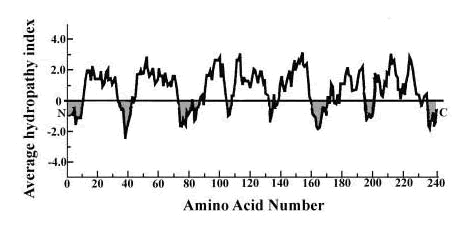Preface | Introduction to Problem Solving | Problem Sets | Acknowledgments
| A.3. Hydropathy Data <<Previous Problem Next Problem>> | PPrint PDF |
(30 pts) The cDNA of a gene coding for an interesting membrane protein has been cloned, amplified and sequenced, and the amino acid sequence of its probable translation product inferred from the nucleotide sequence. The protein contains 240 amino acids and exhibits an apparent molecular weight in SDS-PAGE of approximately 30 kDa. A hydropathy plot of the protein’s primary structure is presented in the figure below, numbering the amino acids from the amino terminal end to the carboxy terminal as is customary (designated "N" and "C" respectively).
 |
Consider these data and answer all the following questions:
a. Why is the protein likely to be an IMP?
b. How many times does this IMP span the membrane? Briefly discuss
the basis for your answer.
c. If a reagent for detecting the amino terminus labeled all of this
protein in intact cells (and no additional protein was labeled in leaky
cells or ghosts), where is the carboxy terminus likely located?
In the cytoplasm or in the extracellular space? Why?
d.What is the likely secondary structure of protein in those regions
spanning the membrane?
e. Two of the several hydrophobic regions of the protein each contain
2 clusters of polar amino acids; each of these clusters contains 1 or
2 polar amino acids. Using 4 arrows indicate the likely locations
of these clusters in the figure above.
f. Assuming these polar clusters are functionally important, hypothesize
a likely function for the protein, draw a reasonable 3-D model for its
membrane organization in the space below, and briefly discuss how the
organization is related to its function.
g. How would you test your hypothesis concerning its function and what
would the results show?